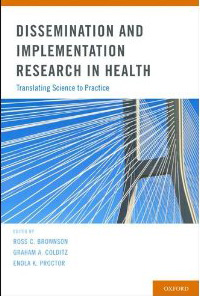 It can take nearly two decades for research discoveries to make their way into public health, mental health and health-care settings. The emerging field of dissemination and implementation (D&I) research seeks to narrow the gap between evidence-based research and routine practice.To help propel this crucial field forward, leading D&I scholars and researchers contributed to Dissemination and Implementation Research in Health: Translating Science to Practice, a new book published by Oxford University Press.
It can take nearly two decades for research discoveries to make their way into public health, mental health and health-care settings. The emerging field of dissemination and implementation (D&I) research seeks to narrow the gap between evidence-based research and routine practice.To help propel this crucial field forward, leading D&I scholars and researchers contributed to Dissemination and Implementation Research in Health: Translating Science to Practice, a new book published by Oxford University Press.
Edited by Washington University in St. Louis researchers Ross C. Brownson, PhD, Graham A. Colditz, MD, DrPH, and Enola K. Proctor, PhD, the book is a roadmap for research translation, with broad appeal for researchers and practitioners in epidemiology, biostatistics, behavioral science, economics, medicine, social work, psychology and anthropology.
“It is incumbent upon every researcher to remember that we don’t conduct research simply to foster additional research, but rather, our goal is to apply what we learn to improve health,” says Brownson, professor and co-director of the Prevention Research Center in St. Louis at the School of Medicine and the Brown School at WUSTL.
“We decided to put together this book in order to document promising methods for shortening the gap between the discovery of new knowledge and its application in the ‘real world.’”
Proctor, the Frank J. Bruno Professor of Social Work Research at the Brown School, notes that the field of dissemination and implementation science is rapidly growing but widely scattered; it has no “disciplinary home.”
“Washington University, with its ease of transdisciplinary collaboration and proclivity for fostering new ideas, has been a wonderful base in which D&I researchers can thrive,” she says.
“Supported by the only extramural NIH training grant in this field, we bring junior investigators and leading researchers in the field to Washington University each year for the Implementation Research Institute, and our Institute of Clinical and Translational Sciences has one of the only D&I research cores in the country.
“Because the field is in early stages of development and because we are deeply involved in training the next, or maybe first, generation of D&I researchers, we knew the time was right for this book, the first of its kind.”
The book offers information on how to evaluate the evidence based on effective interventions; which strategies will produce the greatest impact; how to design an appropriate study; and how to track a set of essential outcomes.
It also tackles the particular dissemination and information challenges in several fields, including the social services, public health clinics, schools, health care and public policy.
Shortening the translational pipeline
“Although we have a remarkable foundation of knowledge in all disciplines related to health care, public health, social services, and mental health, the gap between the care that could be — if it were informed by that knowledge— and the care that is in routine practice has been characterized as a ‘chasm’ by the Institute of Medicine,” Proctor says.
“The ‘translational pipeline’ — which now takes decades — needs to be shortened, and can be — we think — through the promise of D&I science.”
Colditz, the Niess-Gain Professor of Surgery and associate director of Prevention and Control at the Alvin J. Siteman Cancer Center at the School of Medicine, says that a common language and a move toward common tools will help speed this translation to implementation pipeline.
D&I studies also must take into account the barriers to application of evidence-based interventions in the communities where people live their lives and the social service agencies, hospitals and clinics where they receive care.
D&I research holds unique promise for helping ensure that our nation’s investment in basic and clinical research can be translated into improvements in community-based settings. D&I science offers return on investment, and potential to reduce disparities and improve the quality of health and behavioral health care, as well as social services.
“We now have a solid set of tools for conducting D&I science,” Colditz says.
“Our book provides a strong foundation and charts direction for the field’s further development for the next foreseeable years,” he says.
“Scientifically, we still have a long way to go. The next generation of studies should address implementation of evidence-based services within dynamic service delivery systems, and address challenges of sustaining and scaling up quality care for population impact.”
For more information, visit oup.com/us/catalog/general/subject/Medicine/EpidemiologyBiostatistics/?view=usa&ci=9780199751877.